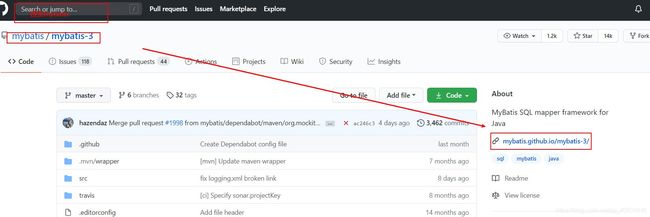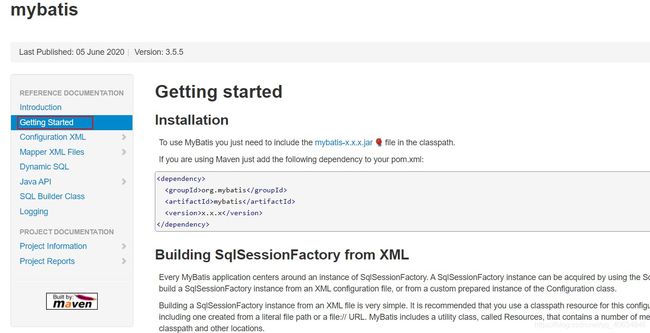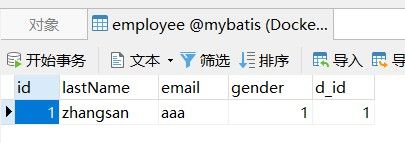Day57——SpringBoot2.x整合MyBatis
文章目录
- 一. 问题背景
- 二. 整合MyBatis
- 2.1 搭建环境
- 2.2 注解版MyBatis
- 2.2.1 步骤
- 2.2.2 配置驼峰命名
- 2.2.2.1 问题背景
- 2.2.2.2 解决方案
- 2.2.2.3 原理
- 2.2.3 指定扫描mapper包
- 2.3 配置版MyBatis
- 2.3.1 步骤
- 2.3.2 报错Invalid statment xxx not found
一. 问题背景
前面学习了Day56——SpringBoot2.x整合Druid&配置数据源监控,今天来学习整合MyBatis
二. 整合MyBatis
2.1 搭建环境
首先搭建好druid数据源,这个步骤与Day56——SpringBoot2.x整合Druid&配置数据源监控一样,步骤如下:
引入依赖:
<dependency>
<groupId>com.alibabagroupId>
<artifactId>druid-spring-boot-starterartifactId>
<version>1.1.17version>
dependency>
配置Druid:
创建application.yaml,在druid属性以下的属性,都是druid-starter依赖所需要配置的。 schema属性以及initialization-mode属性是创建表时要用到的,因此创建完表后应该将schema和initialization-mode 注释掉如下:
spring:
datasource:
# 数据源基本配置
username: root
password: 123456
driver-class-name: com.mysql.cj.jdbc.Driver
url: jdbc:mysql://192.168.32.103:3306/mybatis
type: com.alibaba.druid.pool.DruidDataSource
#首次运行完创建表后,应该将schema和initialization-mode注释掉
# # 指定sql脚本文件路径
# schema:
# - classpath:sql/department.sql
# - classpath:sql/employee.sql
# #设置SpringBoot启动后执行脚本文件
# initialization-mode: always
druid:
initial-size: 5
max-active: 20
min-idle: 5
max-wait: 60000
pool-prepared-statements: true
max-pool-prepared-statement-per-connection-size: 20
validation-query: SELECT 1 FROM DUAL
test-on-borrow: false
test-on-return: false
test-while-idle: true
time-between-eviction-runs-millis: 60000
min-evictable-idle-time-millis: 300000
filter:
stat:
enabled: true
db-type: mysql
log-slow-sql: true
slow-sql-millis: 2000
wall:
enabled: true
slf4j:
enabled: true
keep-alive: true
# 监控过滤器
web-stat-filter:
enabled: true
exclusions:
- "*.js"
- "*.gif"
- "*.jpg"
- "*.png"
- "*.css"
- "*.ico"
- "/druid/*"
#exclusions可以是list格式配置,也可以是String格式
# exclusions: "*.js,*.gif,*.jpg,*.png,*.css,*.ico,/druid/*"
# druid 监控页面
stat-view-servlet:
enabled: true
url-pattern: /druid/*
reset-enable: false
login-username: admin
login-password: 123456
#拒绝本机连接(自行修改自己的本机连接)
deny: 192.168.32.103
配置Druid数据源:
@Configuration
public class DruidConfig {
@Bean
@Primary
@ConfigurationProperties(prefix = "spring.datasource.druid")
public DruidDataSource druidDataSource(){
return DruidDataSourceBuilder.create().build();
}
}
SET FOREIGN_KEY_CHECKS=0;
-- ----------------------------
-- Table structure for department
-- ----------------------------
DROP TABLE IF EXISTS `department`;
CREATE TABLE `department` (
`id` int(11) NOT NULL AUTO_INCREMENT,
`departmentName` varchar(255) DEFAULT NULL,
PRIMARY KEY (`id`)
) ENGINE=InnoDB AUTO_INCREMENT=1 DEFAULT CHARSET=utf8;
employee.sql
SET FOREIGN_KEY_CHECKS=0;
-- ----------------------------
-- Table structure for employee
-- ----------------------------
DROP TABLE IF EXISTS `employee`;
CREATE TABLE `employee` (
`id` int(11) NOT NULL AUTO_INCREMENT,
`lastName` varchar(255) DEFAULT NULL,
`email` varchar(255) DEFAULT NULL,
`gender` int(2) DEFAULT NULL,
`d_id` int(11) DEFAULT NULL,
PRIMARY KEY (`id`)
) ENGINE=InnoDB AUTO_INCREMENT=1 DEFAULT CHARSET=utf8;
首次运行完创建完表后,将yaml文件中的schema属性以及initialization-mode属性注释掉,然后创建Bean:
Employee.java
package com.atguigu.springboot.bean;
public class Employee {
private Integer id;
private String lastname;
private Integer gender;
private String email;
private Integer dId;
public Integer getId() {
return id;
}
public void setId(Integer id) {
this.id = id;
}
public String getLastname() {
return lastname;
}
public void setLastname(String lastname) {
this.lastname = lastname;
}
public Integer getGender() {
return gender;
}
public void setGender(Integer gender) {
this.gender = gender;
}
public String getEmail() {
return email;
}
public void setEmail(String email) {
this.email = email;
}
public Integer getdId() {
return dId;
}
public void setdId(Integer dId) {
this.dId = dId;
}
}
Department.java
package com.atguigu.springboot.bean;
public class Department {
private Integer id;
private String departmentName;
public Integer getId() {
return id;
}
public void setId(Integer id) {
this.id = id;
}
public String getDepartmentName() {
return departmentName;
}
public void setDepartmentName(String departmentName) {
this.departmentName = departmentName;
}
}
至此搭建环境完成
2.2 注解版MyBatis
2.2.1 步骤
使用注解配置mybatis非常简单,只需创建interface并加上@Mapper注释即可,步骤如下:
首先创建一个interface:
DepartmentMapper.java
//指定这是一个操作数据库的mapper
@Mapper
public interface DepartmentMapper {
@Select("select * from department where id = #{id}")
public Department getDeptById(Integer id);
@Delete("delete from department where id = #{id}")
public int deleteDeptById(Integer id);
@Options(useGeneratedKeys = true,keyProperty = "id")//插入后返回主键
@Insert("insert into department(department_name) values(#{departmentName})")
public int insertDept(Department department);
@Update("update department set department_name = #{departmentName} where id = #{id}")
public int updateDept(Department department);
}
解释: 所有的增删改查只需使用@Insert、@Delete、@Update、@Select书写sql语句,如果插入数据后需要返回主键,只需使用@Option(useGeneratedKeys=true, keyProperty="id")。
为了方便讲述,这里不再创建Service这些,直接创建Controller:
DeptController.java
@RestController
public class DeptController {
@Autowired
DepartmentMapper departmentMapper;
@GetMapping("/dept/{id}")
public Department getDepartment(@PathVariable("id") Integer id){
return departmentMapper.getDeptById(id);
}
@GetMapping("/dept")
public Department insertDept(Department department){
departmentMapper.insertDept(department);
return department;
}
}
至此就完成了整合MyBatis。
2.2.2 配置驼峰命名
2.2.2.1 问题背景
假如将数据库字段名改成有下划线的格式,比如将departmentName改成department_name,执行sql语句还成功吗?

修改sql语句对应的数据库字段名为下划线格式,如下:
@Options(useGeneratedKeys = true,keyProperty = "id")//插入后返回主键
@Insert("insert into department(department_name) values(#{departmentName})")
public int insertDept(Department department);
@Update("update department set department_name = #{departmentName} where id = #{id}")
public int updateDept(Department department);
2.2.2.2 解决方案
只需创建一个配置类,并注册一个ConfigurationCustomizer到容器中,重写customize()方法,在方法里面开启驼峰命名规则,如下:
@Configuration
public class MyBatisConfig {
@Bean
public ConfigurationCustomizer configurationCustomizer(){
return new ConfigurationCustomizer() {
@Override
public void customize(org.apache.ibatis.session.Configuration configuration) {
configuration.setMapUnderscoreToCamelCase(true);//开启驼峰命名法
}
};
}
}
2.2.2.3 原理
按2下shift搜索并打开MyBatisAutoConfiguration,有一个注册SqlSessionFactory的方法,如下:
@Bean
@ConditionalOnMissingBean
public SqlSessionFactory sqlSessionFactory(DataSource dataSource)
throws Exception {
...
this.applyConfiguration(factory);//关键方法
...
}
applyConfiguration()方法非常关键,如下:
private void applyConfiguration(SqlSessionFactoryBean factory) {
if (configuration != null && !CollectionUtils.isEmpty(this.configurationCustomizers)) {
Iterator var3 = this.configurationCustomizers.iterator();
while(var3.hasNext()) {
//拿到的ConfigurationCustomizer并调用它的customize()方法
ConfigurationCustomizer customizer = (ConfigurationCustomizer)var3.next();
customizer.customize(configuration);
}
}
}
解释: 可以看到,注册SqlSessionFactory的时候,会拿到的ConfigurationCustomizer并调用它的customize()方法
2.2.3 指定扫描mapper包
情景: 一个一个地给每个Mapper加@Mapper注解很繁琐,我们可以使用@MapperScan(basicPackage="xxx")指定mapper包的路径。
步骤:
在主配置类上加上@MapperScan(value = "com.atguigu.springboot.mapper"),如下:
@MapperScan(value = "com.atguigu.springboot.mapper")
@SpringBootApplication
public class SpringBoot06DataMybatisApplication {
2.3 配置版MyBatis
2.3.1 步骤
首先创建EmployeeMapper.java,如下:
//@Mapper或者@MapperScan将接口扫描到容器中
//@Mapper
public interface EmployeeMapper {
public Employee getEmpById(Integer id);
public void insertEmp(Employee employee);
}
创建EmployeeMapper.xml,如下:
<mapper namespace="com.atguigu.springboot.mapper.EmployeeMapper">
<select id="getEmpById" resultType="com.atguigu.springboot.bean.Employee">
SELECT * FROM employee WHERE id=#{id}
select>
<insert id="insertEmp">
INSERT INTO employee(lastName,email,gender,d_id)
VALUES (#{lastName},#{email},#{gender},#{dId})
insert>
mapper>
创建mybatis-config.xml,如下:
<configuration>
<settings>
以上两个mybatis的xml文件模板可以去mybatis官方文档查看,如下:


指定mybatis的xml映射文件以及全局配置文件的位置:
mybatis:
# 指定全局配置文件位置
config-location: classpath:mybatis/mybatis-config.xml
# 指定sql映射文件位置
mapper-locations: classpath:mybatis/mapper/*.xml
创建controller,如下:
@RestController
public class DeptController {
@Autowired
EmployeeMapper employeeMapper;
@GetMapping("/emp/{id}")
public Employee getEmpById(@PathVariable("id") Integer id){
return employeeMapper.getEmpById(id);
}
}
2.3.2 报错Invalid statment xxx not found
如果所有的配置无误但就是报错,而且是Invalid statement xxx not found,那么可以看看proeprties文件是否也配置了mybatis相关的配置,详情看:SpringBoot整合Mybatis启动报错Invalid Statement xxx not found







